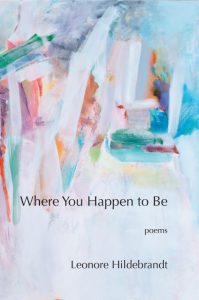Praise for Where You Happen to Be
In Where You Happen to Be , Leonore Hildebrandt writes of “discern[ing] layers / of sound and scent,” of probing “the human dilemma / of purpose and failure.” The poems in this collection assume this task of recognition and discovery. Gently, and with a great and detailed patience, she walks us through physical and emotional landscapes, narrating travels that feel both in and out of time. “The living,” Hildebrandt writes, “inherit the world’s blindness— / so much of it, they get blissfully drunk.” Yet as her poems celebrate and mourn our blindness, they also remind us, again and again, of the power of resilience: “Let one lake rest on another.”
—Dawn Potter
The reigning intelligence in Leonore Hildebrandt’s Where You Happen to Be is a wanderer over physical, political, and spiritual landscapes. Intensely observant, ever aware of the contingency of her present circumstances, Hildebrandt carries the reader from the Maine coast, where “the ocean was right in its fervor” to the arid hills of northern New Mexico, their “desert patina . . . chiseled” with petroglyphs; from ominous urban ruins to the great, dark forests of fairy tales and the unconscious. Do not come to these poems looking for peaceful resolution; this poet is too busy with the work of being “unconstructed / uncontrolled / unstoppable.” But do come to these poems.
—Lee Sharkey
With variously sized poetic scopes, ever focused, Leonore Hildebrandt finds us connective paths through space and time, delineating the material and spiritual dimensions of shelter. Where You Happen to Be takes its cue—and title—from Buckminster Fuller’s directive: “The most important thing to teach your children is that the sun does not rise and set. It is the Earth that revolves around the sun. Then teach them the concepts of North, South, East and West, and that they relate to where they happen to be on the planet’s surface at that time.” A poet of the keenest relational reasoning, Hildebrandt marks out the directions of a nostos poetics, venturing, but never claiming, the way home. Her precision of image and tone is all the more indelible for this concomitant spirit of wandering. This is a book you read in one fascinated swoop, then return to again and again with love and gratitude. There are so few books of contemporary poetry contributing to what I’d call a “wisdom tradition.” This is most certainly one of them.
—Sarah Gridley

